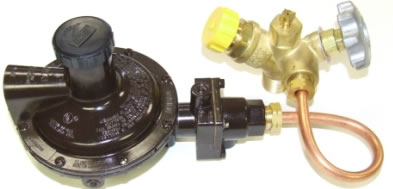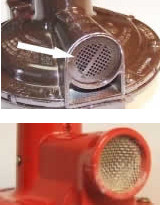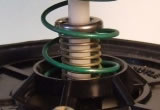Propane Regulator Parts and Important Facts

Because the regulator is such an important device in any propane gas system, it is important to know how the regulator works. A better understanding of propane regulator operation is imperative for customers to have so that the recommendations concerning regulators from the propane company representative are fully understood. When the subject of regulator replacement is addressed by the propane company, be sure to listen and heed their advice. Above all else, DO NOT ATTEMPT TO MODIFY OR TAMPER WITH A PROPANE REGULATOR.
Regulator Vent

The regulator vent allows the regulator to "breathe" during normal operation and functions as a pressure relief opening in an overpressure situation. It should remain free of dirt and debris for the purpose of safety. If the regulator vent becomes blocked or the airflow is restricted for any reason, the regulator may operate incorrectly and present an unsafe situation for gas appliances downstream from the regulator. For this reason, propane regulators must be pointed down, covered and protected, or have an adapter attached that places the vent opening in a downward facing position. The vent opening must be protected so that insects, water, debris or other elements are unable to enter the regulator vent opening. From a propane company standpoint, ensuring that the regulator vent is protected from the elements is one thing consumers can actively do to ensure their regulator operates properly.
LPG Regulator Diaphragm

The regulator diaphragm is a flexible rubber disc that "senses" pressure changes and operates to adjust the flow of gas to the proper flow rate. The diaphragm works in conjunction with springs and other parts on the interior of the regulator to ensure safe flow rates and pressures downstream of the regulator. It works in conjunction with the regulator vent which allows the diaphragm to move up and down freely. If the vent is obstructed, the diaphragm will not operate properly causing a regulator lock-up or overpressure situation.
LPG Regulator Pressure Relief Valve

Propane regulators are manufactured with pressure relief devices built inside the regulator body and operate in a similar manner as that of a tank pressure relief valve. If triggered, the relief valve will open and allow gas to escape through the regulator vent. The vent needs to remain unobstructed so that the gas may escape if necessary.
